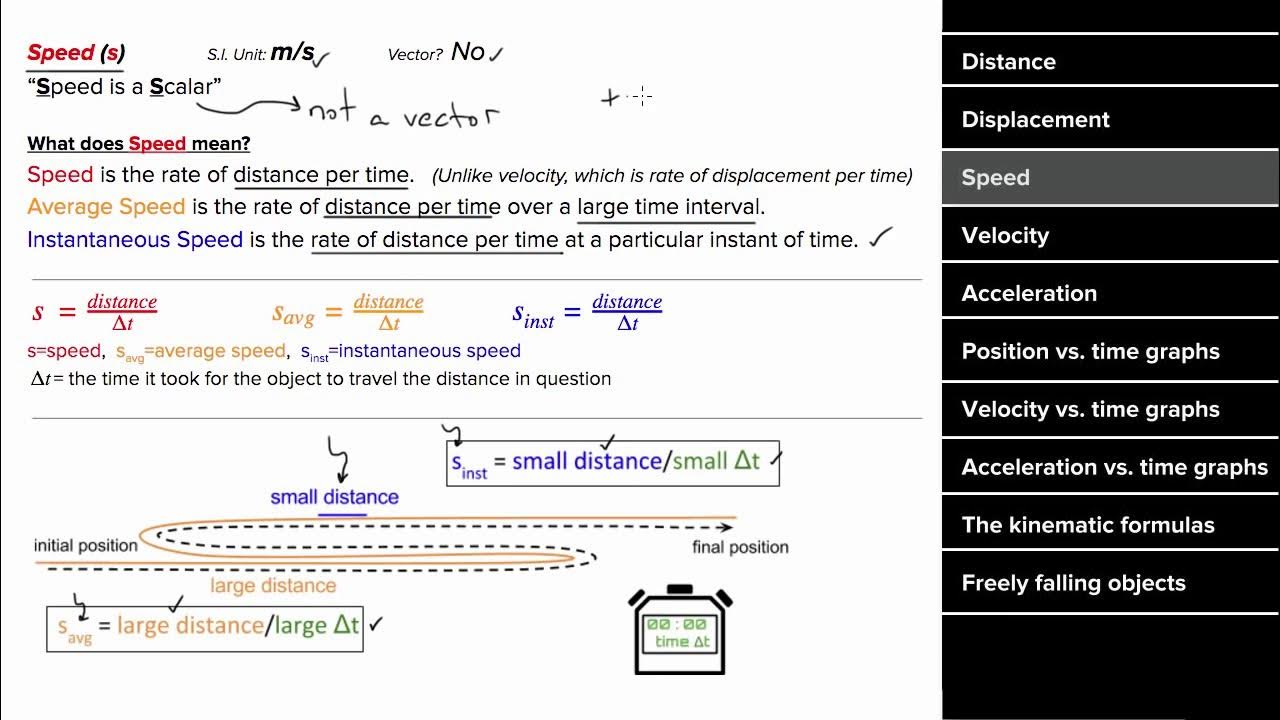What Are Speed and Velocity? | Physics in Motion
TLDRThis video script delves into the distinct concepts of speed and velocity, highlighting their differences and relevance in physics. Speed is described as a scalar quantity, focusing on the rate of distance covered without direction, whereas velocity is a vector quantity, encompassing both magnitude and direction. The segment clarifies how to calculate average speed and velocity, introduces instantaneous velocity, and contrasts constant velocity. It also explains how the direction of velocity is determined by chosen positive and negative reference directions and demonstrates how velocity can be understood and calculated using position-time graphs.
Takeaways
- 🚗 Speed and velocity are distinct concepts in physics, with speed being a scalar quantity and velocity being a vector quantity.
- 📏 Speed is the rate at which an object covers distance, measured in meters per second, and always has a positive value regardless of direction.
- 🎯 Velocity includes both magnitude and direction, with the SI unit also being meters per second, and can have positive or negative values based on the chosen direction.
- 🔄 The average speed of an object is calculated by dividing the total distance traveled by the total time taken.
- 🏁 Average velocity considers displacement (change in position) over time and can differ from average speed, especially in cases of back-and-forth motion.
- 📐 Displacement is the point-to-point difference in position and is different from the total distance traveled.
- ➡️ Positive and negative directions are chosen by the observer, typically with right and up considered positive, and left and down negative.
- 🚀 Instantaneous velocity is the velocity of an object at a specific point in time, whereas average velocity is the overall velocity over a period.
- 📊 A position-time graph can be used to represent an object's velocity, with the slope of the line indicating the velocity.
- 🌟 Constant velocity is represented by a straight line on a position-time graph, indicating uniform motion at a steady pace.
- 🛠️ For detailed analysis of velocity, including average and instantaneous, one can refer to the 'Physics in Motion' Toolkit for practice problems and resources.
Q & A
What is the main difference between speed and velocity?
-Speed is a scalar quantity that refers to the rate at which an object covers distance, while velocity is a vector quantity that includes both magnitude and direction.
What is the SI unit for both speed and velocity?
-The SI unit for both speed and velocity is meters per second.
Why is speed always a positive value?
-Speed is always a positive value because it only considers the magnitude of how fast an object is moving, without taking direction into account.
How is average speed calculated?
-Average speed is calculated by dividing the total distance traveled by the total time taken.
How is average velocity different from average speed?
-Average velocity takes into account both the magnitude and direction of an object's movement, whereas average speed only considers the magnitude.
What is the relationship between displacement and average velocity?
-Average velocity is calculated by dividing the displacement (change in position) by the change in time.
How do you establish a frame of reference for velocity?
-A frame of reference for velocity is established by choosing a positive and negative direction, which is typically right as positive and left as negative.
What is instantaneous velocity?
-Instantaneous velocity is the velocity of an object at a specific point in time, as opposed to average velocity, which considers the overall velocity over the course of an entire journey.
What is a position time graph and how is it used to analyze velocity?
-A position time graph is a graphical representation where the time elapsed is on the X axis and the object's position is on the Y axis. The slope of the line on this graph indicates the object's velocity.
How can you determine if an object is moving at constant velocity from a position time graph?
-An object is moving at constant velocity if its position time graph shows a straight line with a constant slope, indicating that the object is covering equal distances in equal intervals of time.
What is the significance of the slope in a position time graph?
-The slope in a position time graph represents the velocity of the object. A positive slope indicates movement in the positive direction, while a negative slope indicates movement in the negative direction.
Outlines
🏎️ Understanding Speed and Velocity
This paragraph introduces the concepts of speed and velocity, highlighting their differences and importance in physics. Speed is defined as the rate at which an object covers distance and is a scalar quantity, meaning it only has magnitude and no direction. The segment uses the example of cars at the Porsche Experience Center to illustrate how speed is calculated and why direction is irrelevant to it. Velocity, on the other hand, is a vector quantity that includes both magnitude and direction. The distinction between the two is clarified through the calculation of average speed and velocity using examples of a car's movement on a track. The segment emphasizes the need to establish a frame of reference when dealing with velocity and explains how positive and negative directions can be chosen for analysis.
📈 Analyzing Average and Instantaneous Velocity
This paragraph delves deeper into the concepts of average and instantaneous velocity, as well as constant velocity. It explains that average velocity provides an overall measure of an object's motion over a journey, focusing on displacement divided by the change in time. Instantaneous velocity, however, refers to the velocity of an object at a specific point in time. The segment uses the analogy of a car accelerating to illustrate how instantaneous velocity changes at different moments. The concept of constant velocity is introduced as unchanging velocity, and the ways to represent it through position-time graphs are discussed. The graph's slope indicates an object's velocity, with positive and negative slopes representing movement away from or towards the origin, respectively. The segment concludes by summarizing the key points discussed and encourages further exploration of these concepts through practice problems and resources like the 'Physics in Motion' Toolkit.
Mindmap
Keywords
💡Speed
💡Velocity
💡Scalar Quantity
💡Vector Quantity
💡Displacement
💡Average Speed
💡Average Velocity
💡Instantaneous Velocity
💡Constant Velocity
💡Position-Time Graph
Highlights
The distinction between speed and velocity is clarified, emphasizing that speed is a scalar quantity, while velocity is a vector quantity.
Speed is defined as the rate at which an object covers distance, with its SI unit being meters per second.
The direction of movement does not affect speed, as it is a scalar quantity and always positive.
The formula for calculating average speed is provided, which is total distance divided by total time.
An example is given to calculate the average speed of a car, demonstrating the use of the formula.
Velocity is introduced as a vector quantity with both magnitude and direction, also measured in meters per second.
Average velocity accounts for displacement over time and requires a frame of reference to determine positive and negative directions.
The difference between average speed and average velocity is illustrated with a car's round trip, showing they can have different values.
Instantaneous velocity is defined as the velocity of an object at a specific point in time, differing from average velocity.
Constant velocity is described as unchanging velocity throughout a movement.
The representation of velocity is discussed, including average, instantaneous, and constant velocity.
Position time graphs are introduced as a tool to analyze an object's velocity through the slope of the line.
The slope of a line on a position time graph indicates the velocity of an object, with positive and negative slopes representing direction.
The transcript concludes with a summary of the key concepts discussed, including speed, velocity, and their various types.
The "Physics in Motion" Toolkit is mentioned as a resource for further practice, lab activities, and note-taking guides.
The segment wraps up with an invitation to the next episode for more insights into physics.
Transcripts
Browse More Related Video

11 - What is Definition of Average Speed & Velocity in Physics? (Speed Formula & Velocity Formula)

What is Velocity? - Full Concept of Velocity - Physics | Infinity Learn

AP Physics 1 review of 1D motion

What is Velocity? Physics

Velocity and speed: Motion in One Dimension

What is Speed, Velocity & Acceleration? | Physics
5.0 / 5 (0 votes)
Thanks for rating: